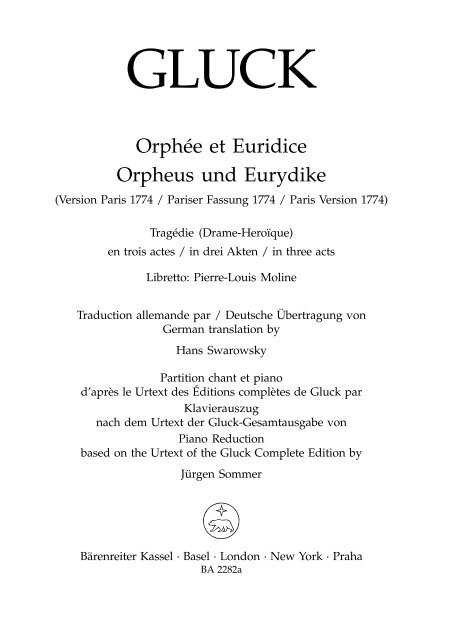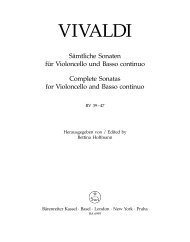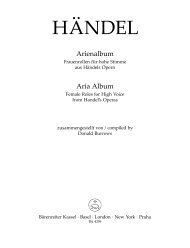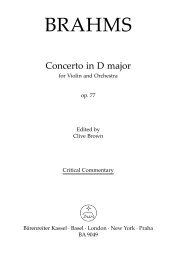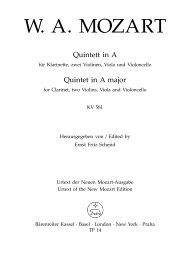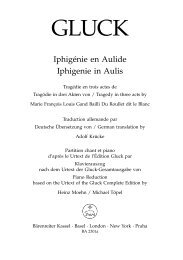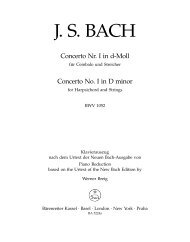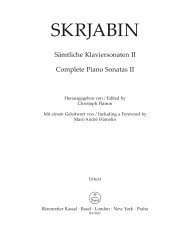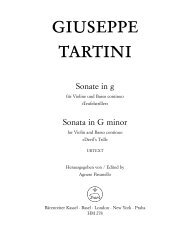Orphée et Euridice Orpheus und Eurydike Seite 1 - Clarius Audi
Orphée et Euridice Orpheus und Eurydike Seite 1 - Clarius Audi
Orphée et Euridice Orpheus und Eurydike Seite 1 - Clarius Audi
Create successful ePaper yourself
Turn your PDF publications into a flip-book with our unique Google optimized e-Paper software.
<strong>Seite</strong> 1<br />
GLUCK<br />
<strong>Orphée</strong> <strong>et</strong> <strong>Euridice</strong><br />
<strong>Orpheus</strong> <strong>und</strong> <strong>Eurydike</strong><br />
(Version Paris 1774 / Pariser Fassung 1774 / Paris Version 1774)<br />
Tragédie (Drame-Heroïque)<br />
en trois actes / in drei Akten / in three acts<br />
Libr<strong>et</strong>to: Pierre-Louis Moline<br />
Traduction allemande par / Deutsche Übertragung von<br />
German translation by<br />
Hans Swarowsky<br />
Partition chant <strong>et</strong> piano<br />
d’après le Urtext des Éditions complètes de Gluck par<br />
Klavierauszug<br />
nach dem Urtext der Gluck-Gesamtausgabe von<br />
Piano Reduction<br />
based on the Urtext of the Gluck Compl<strong>et</strong>e Edition by<br />
Jürgen Sommer<br />
Bärenreiter Kassel · Basel · London · New York · Praha<br />
BA 2282a
TABLE / INHALT / CONTENTS<br />
Ensemble / Bes<strong>et</strong>zung . . . . . . . . . . . . . . . . . . . . . . . . . . . . . . . . . . . . . . . . . . .<br />
Avant-propos . . . . . . . . . . . . . . . . . . . . . . . . . . . . . . . . . . . . . . . . . . . . . . . . . . .<br />
Vorwort . . . . . . . . . . . . . . . . . . . . . . . . . . . . . . . . . . . . . . . . . . . . . . . . . . . . . . . .<br />
Preface . . . . . . . . . . . . . . . . . . . . . . . . . . . . . . . . . . . . . . . . . . . . . . . . . . . . . . . . .<br />
Index de scènes / Verzeichnis der Szenen . . . . . . . . . . . . . . . . . . . . . . . . . .<br />
III<br />
IV<br />
V<br />
VII<br />
IX<br />
Ouverture . . . . . . . . . . . . . . . . . . . . . . . . . . . . . . . . . . . . . . . . . . . . . . . . . . . . . . 1<br />
Acte premier / Erster Akt . . . . . . . . . . . . . . . . . . . . . . . . . . . . . . . . . . . . . . . . 8<br />
Acte deuxième / Zweiter Akt . . . . . . . . . . . . . . . . . . . . . . . . . . . . . . . . . . . . . 49<br />
Acte troisième / Dritter Akt . . . . . . . . . . . . . . . . . . . . . . . . . . . . . . . . . . . . . . 130<br />
Ball<strong>et</strong> / Ball<strong>et</strong>t . . . . . . . . . . . . . . . . . . . . . . . . . . . . . . . . . . . . . . . . . . . . . . . . . . 196<br />
En plus de la partition chant <strong>et</strong> piano il existe aussi la partition<br />
de direction (BA 2282) <strong>et</strong> le matériel d’orchestre (BA 2282, en location).<br />
Neben diesem Klavierauszug sind die Dirigierpartitur (BA 2282)<br />
<strong>und</strong> das Aufführungsmaterial (BA 2282, leihweise) erhältlich.<br />
In addition to the present vocal score, the full score (BA 2282)<br />
and the compl<strong>et</strong>e orchestral parts (BA 2282, on hire) are also available.<br />
Édition d’après: Christoph Willibald Gluck, Sämtliche Werke, publiée par Institut für Musikforschung Berlin<br />
avec le soutien de la cité Hannover, établi par Rudolf Gerber, série I, volume 6:<br />
<strong>Orphée</strong> <strong>et</strong> Éuridice (BA 2282) éditée par Ludwig Finscher.<br />
Ausgabe nach: Christoph Willibald Gluck: Sämtliche Werke, herausgegeben im Auftrag des<br />
Instituts für Musikforschung Berlin mit Unterstützung der Stadt Hannover, begründ<strong>et</strong> von Rudolf Gerber,<br />
Abteilung I, Band 6: <strong>Orphée</strong> <strong>et</strong> <strong>Euridice</strong> (BA 2282), vorgelegt von Ludwig Finscher.<br />
Supplementary edition based on: Chistoph Willibald Gluck, Sämtliche Werke, edited on behalf of the<br />
Institut für Musikforschung Berlin, subsidized by the city of Hannover, established by Rudolf Gerber,<br />
Series I, Volume 6: <strong>Orphée</strong> <strong>et</strong> <strong>Euridice</strong> (BA 2282), edited by Ludwig Finscher.<br />
© 1967 by Bärenreiter-Verlag Karl Vötterle GmbH & Co. KG, Kassel<br />
6 e Tirage / 6. Auflage / 6th Printing 2007<br />
Tous droits réservés / Alle Rechte vorbehalten / All rights reserved / Printed in Germany<br />
Toute reproduction est interdite par la loi. / Vervielfältigungen jeglicher Art sind ges<strong>et</strong>zlich verboten.<br />
Any unauthorized reproduction is prohibited by law.<br />
ISMN M-006-41956-2
ENSEMBLE / BESETZUNG<br />
PERSONNAGES<br />
<strong>Orphée</strong> . . . . . . . . . . . . . . . . . . . . . . . . . . . . . . . . . . . . . . . . . . . . . . . . . . . . Ténor 13<br />
<strong>Euridice</strong> . . . . . . . . . . . . . . . . . . . . . . . . . . . . . . . . . . . . . . . . . . . . . . . . . . . Soprano 104<br />
L’Amour . . . . . . . . . . . . . . . . . . . . . . . . . . . . . . . . . . . . . . . . . . . . . . . . . . Soprano 28<br />
Chœurs de Bergers <strong>et</strong> de Bergères, de Nymphes, de Démons <strong>et</strong> de Furies, d’Ombres<br />
heureuses, de Héros <strong>et</strong> d’Héroïnes.<br />
Les nombres indiquent la première entrée de la partie.<br />
PERSONEN<br />
<strong>Orpheus</strong> . . . . . . . . . . . . . . . . . . . . . . . . . . . . . . . . . . . . . . . . . . . . . . . . . . . Tenor 13<br />
<strong>Eurydike</strong> . . . . . . . . . . . . . . . . . . . . . . . . . . . . . . . . . . . . . . . . . . . . . . . . . . Sopran 104<br />
Amor . . . . . . . . . . . . . . . . . . . . . . . . . . . . . . . . . . . . . . . . . . . . . . . . . . . . . Sopran 28<br />
Chöre der Schäfer <strong>und</strong> Schäferinnen, der Nymphen, der Dämonen <strong>und</strong> Furien,<br />
der seligen Geister, der Heroen <strong>und</strong> Heroinen.<br />
Die Zahlen bezeichnen den ersten Einsatz der Partie.<br />
CHARACTERS<br />
<strong>Orpheus</strong> . . . . . . . . . . . . . . . . . . . . . . . . . . . . . . . . . . . . . . . . . . . . . . . . . . . tenor 13<br />
Eurydice . . . . . . . . . . . . . . . . . . . . . . . . . . . . . . . . . . . . . . . . . . . . . . . . . . soprano 104<br />
Cupid . . . . . . . . . . . . . . . . . . . . . . . . . . . . . . . . . . . . . . . . . . . . . . . . . . . . . soprano 28<br />
Chorus of shepherds and shepherdesses, chorus of nymphs, chorus of demons<br />
and furies, chorus of the blessed spirits, chorus of heroes and heroines.<br />
The numbers denote the first entry of the part.<br />
ORCHESTRA<br />
Flauto I, II, Oboe I, II, Clarin<strong>et</strong>to I, II, Fagotto I, II;<br />
Corno I, II, Tromba I, II, Trombone I–III;<br />
Timpani; Arpa; Archi
AVANT-PROPOS<br />
La «tragédie opéra» «<strong>Orphée</strong> <strong>et</strong> <strong>Euridice</strong>», le<br />
deuxième opéra réformé français de Gluck, constitue<br />
un arrangement de l’«azione teatrale» italienne<br />
par lequel le compositeur, dès 1762, avait<br />
commencé à s’attacher à proprement parler à son<br />
opéra réformé. C’est sans doute à Vienne, alors<br />
qu’il préparait son voyage à Paris <strong>et</strong> composait<br />
«Iphigénie», que Gluck envisagea de faire suivre<br />
«Iphigénie en Aulide» non pas par une œuvre<br />
originale mais par un arrangement de son «Orfeo<br />
ed <strong>Euridice</strong>», son plus célèbre opéra italien; son<br />
plan, qui était de réduire le poids évident du travail<br />
qui l’attendait à Paris, de bénéficier du succès<br />
de l’original italien ainsi que de tirer profit<br />
de l’édition de la partition faite à Paris en 1764<br />
<strong>et</strong> de la première traduction en prose du texte de<br />
Calzabigi par un auteur anonyme, la même année,<br />
s’adaptait bien avec la stratégie envisagée<br />
par le compositeur pour conquérir la métropole<br />
lyrique française.<br />
Nous ignorons toutefois la date à laquelle il<br />
commença à travailler à «<strong>Orphée</strong>». De nombreux<br />
détails perm<strong>et</strong>tent cependant de penser que les<br />
travaux préliminaires remontent à la collaboration<br />
de Gluck avec Pierre-Louis Moline, son<br />
adaptateur de livr<strong>et</strong>s, bien avant l’arrivée du musicien<br />
à Paris, mi-novembre 1773. La création<br />
d’«<strong>Orphée</strong>» eut lieu le 2 août 1774 à l’Académie<br />
Royale de Musique, <strong>et</strong> la partition fut gravée<br />
presque en même temps.<br />
La traduction du texte ne réussit pas tout de<br />
suite <strong>et</strong> souleva quelques difficultés; des modifications<br />
furent en eff<strong>et</strong> apportées jusqu’au dernier<br />
moment, avant la première représentation, ou en<br />
tout cas avant la publication. De la même façon,<br />
l’adaptation musicale de l’original italien eut lieu<br />
dans la hâte <strong>et</strong> souleva quelques problèmes dus<br />
non seulement aux modifications rendues nécessaires<br />
par la traduction – dans la prosodie <strong>et</strong> le<br />
nombre des syllabes du texte sous la musique –<br />
mais également par des bouleversements <strong>et</strong> des<br />
modifications dans le domaine dramatico-musical.<br />
Naturellement, les plus grandes modifications<br />
qui s’avérèrent nécessaires concernaient les récitatifs,<br />
dont les parties chantées <strong>et</strong> l’accompagnement<br />
par les cordes durent être recomposés presque<br />
intégralement, tandis que la versification put<br />
être reprise plus ou moins fidèlement. Le changement<br />
le plus délicat fut sans aucun doute rencontré<br />
dans la transformation du rôle du castrat <strong>Orphée</strong><br />
en ténor dramatique, changement qui ne fut<br />
certainement pas imposée uniquement par la tradition<br />
parisienne. Ici, tout comme dans d’autres<br />
modifications souvent essentielles dans l’instrumentation,<br />
on peut constater combien Gluck<br />
s’efforçait de s’adapter aux conditions <strong>et</strong> aux possibilités<br />
de l’Académie Royale, sans vouloir sacrifier<br />
les qualités sonores prépondérantes.<br />
Le vaste élargissement de l’œuvre – le bref<br />
opéra pastoral était devenu une tragédie lyrique<br />
(même relativement courte) – imposa, si l’on compare<br />
avec «Orfeo», une nouvelle répartition des<br />
scènes. Toutefois malgré toutes les modifications,<br />
transpositions <strong>et</strong> élargissements opérés dans la<br />
nouvelle œuvre <strong>et</strong> malgré tous les compromis de<br />
détail, elle se présente comme une entité véritablement<br />
artistique, qui s’affirme par son caractère<br />
personnel <strong>et</strong> sa valeur particulière, tout en<br />
présentant même certains avantages formels <strong>et</strong><br />
dramaturgiques.<br />
La présente édition correspond dans ses grandes<br />
lignes à la partition publiée en 1774 sous la<br />
direction de Gluck. La principale modification<br />
réside dans la place du trio de la scène finale du<br />
troisième acte, placé dans la partition imprimée<br />
au milieu du ball<strong>et</strong>-divertissement (erreur du<br />
graveur?). 1 Le livr<strong>et</strong> de la création <strong>et</strong> une critique<br />
du «Journal des Beaux-Arts» relatant la première<br />
représentation prouvent incontestablement<br />
que c<strong>et</strong> ordre ne saurait avoir correspondu aux<br />
intentions de Gluck. Le responsable de la présente<br />
édition s’est de ce fait résolu – dans ce cas<br />
primordial pour la dramaturgie de l’œuvre – à<br />
suivre le livr<strong>et</strong> plutôt que la partition <strong>et</strong> à rétablir<br />
l’ordre plus convainquant qui fut celui de la<br />
création. De la sorte, il semble possible de laisser<br />
de côté la totalité du ball<strong>et</strong>-divertissement, lors<br />
des représentations, ce qui constitue sans doute<br />
une possibilité envisagée par Gluck.<br />
Ajoutons encore quelques indications pratiques<br />
pour la représentation scénique:<br />
1 Voir l’avant-propos de la partition (BA 2282).<br />
IV
Il convient de suivre à la l<strong>et</strong>tre les indications<br />
de tempo <strong>et</strong> les signes dynamiques requis par<br />
Gluck, de ne pas les anémier sous prétexte d’historisme<br />
mal compris – en particulier pour l’Allegro<br />
molto <strong>et</strong> les accents dynamiques violents de<br />
l’Ouverture, ainsi que pour le «à demi-jeu» (sotto<br />
voce) imposé à plusieurs reprise, ou la fin ff de<br />
«J’ai perdu».<br />
L’orchestre peut avoir une distribution importante<br />
si les proportions entre les différents groupes<br />
d’instruments sont maintenues. Mais il n’y a<br />
aucun avantage (contrairement, en partie tout au<br />
moins, à «Orfeo») à interpréter «<strong>Orphée</strong>» sur des<br />
instruments «historiques», puisque les instruments<br />
d’orchestre utilisés à Paris aux environs de<br />
1774 étaient plus proches de nos instruments modernes<br />
que de ceux du début du XVIIIème siècle.<br />
Ceci vaut aussi pour le groupe des basses (bassons,<br />
violoncelles, contrebasses), fortement représentés<br />
si l’on en croit les listes de musiciens de<br />
l’Académie Royale. Leur force sert en quelque<br />
sorte à remplacer la basse continue absente ou<br />
ce qui en tenait lieu. «<strong>Orphée</strong>» ne compte plus<br />
sur le clavecin de la basse continue (contrairement,<br />
ici aussi, à «Orfeo»), bien que l’Académie<br />
Royale ait encore disposé de clavecins <strong>et</strong> de clavecinistes<br />
auxquels elle devait avoir recours pour<br />
son répertoire en partie plus ancien. En tout cas,<br />
le clavecin est inutile comme instrument de direction,<br />
puisque le chef d’orchestre dirigeait les<br />
représentations de l’Académie Royale avec une<br />
bagu<strong>et</strong>te ou un rouleau de musique, en battant<br />
du pied ou en donnant des ordres de la voix (ce<br />
qui – sauf pour la bagu<strong>et</strong>te – ne devrait, de préférence,<br />
pas être imité).<br />
La partie alto des chœurs doit être confiée,<br />
dans la mesure du possible au moins pour moitié,<br />
à des voix masculines aiguës, mais ne forçant<br />
pas. Le rôle d’<strong>Orphée</strong> doit être chanté par un ténor<br />
dramatique capable d’assumer les énormes<br />
contraintes physiques du rôle, <strong>et</strong> possédant des<br />
aigus aussi aisés que possible; il devra avoir de<br />
préférence une formation technique non pas italienne,<br />
mais française ou allemande. C’est la distribution<br />
de ce rôle qui fera le succès ou l’échec<br />
de c<strong>et</strong>te œuvre dans la pratique.<br />
Contrairement à l’édition d’«Orfeo», <strong>et</strong> de façon<br />
tout à fait consciente, nous n’avons que rarement<br />
résolu les signes d’appoggiature dans<br />
«<strong>Orphée</strong>» (dans des notes plus p<strong>et</strong>ites au-dessus<br />
de la portée de la partie de chant concernée).<br />
Ceci correspond tant à la tradition d’interprétation<br />
française qu’au caractère cadencé typique<br />
du récitatif français, que Gluck a cherché à imiter<br />
dans son arrangement d’«Orfeo» en «<strong>Orphée</strong>»,<br />
même s’il ne l’a pas toujours fait de manière très<br />
suivie.<br />
L’éditeur s’estimerait très heureux que, grâce<br />
à son travail, «<strong>Orphée</strong>» de Gluck puisse trouver<br />
sa place sur nos scènes lyriques, sous la forme<br />
proposée ici, <strong>et</strong> soujaiterait avec «Orfeo» bannir<br />
de la pratique les versions malheureuses, mitigées<br />
à partir des deux œuvres.<br />
Ludwig Finscher<br />
(Traduction: Geneviève Geffray)<br />
VORWORT<br />
Die „Tragédie opéra“ <strong>Orphée</strong> <strong>et</strong> <strong>Euridice</strong>, Glucks<br />
zweite französische Reformoper, ist eine Umarbeitung<br />
der italienischen „Azione teatrale“, mit<br />
welcher der Komponist 1762 seine Opernreform<br />
im eigentlichen Sinne begonnen hatte. Den Plan,<br />
der Iphigénie en Aulide kein zweites Originalwerk,<br />
sondern die Bearbeitung von Orfeo ed <strong>Euridice</strong>, der<br />
berühmtesten seiner italienischen Opern, folgen<br />
zu lassen, hat Gluck vermutlich schon in Wien<br />
während der Vorbereitung der Pariser Reise <strong>und</strong><br />
der Komposition der Iphigénie gefasst; der sicherlich<br />
zugr<strong>und</strong>eliegende Gedanke, die voraussehbare<br />
Arbeitslast in Paris ökonomisch zu mindern,<br />
vom Ruhm der italienischen Vorlage zu zehren<br />
<strong>und</strong> auf deren Bekanntheit durch den Pariser Partiturdruck<br />
von 1764 <strong>und</strong> eine erste Prosa-Übers<strong>et</strong>zung<br />
des Calzabigi-Textes durch einen Anonymus<br />
im selben Jahr zu bauen, passt gut zu der geradezu<br />
strategischen Umsicht, mit der die Eroberung<br />
der französischen Opernm<strong>et</strong>ropole geplant wurde.<br />
V
Hauptü groß, wenn es noch mehrere Arten/<br />
Formen von Unterüberschriften gibt /vgl. BA<br />
4063a, Israel in Egypt)<br />
Wann die eigentliche Arbeit am <strong>Orphée</strong> begann,<br />
wissen wir jedoch nicht. Allerdings deut<strong>et</strong><br />
vieles darauf hin, dass die vorbereitenden Arbeiten<br />
<strong>und</strong> das Zusammenwirken Glucks mit seinem<br />
Textbearbeiter Pierre-Louis Moline schon vor<br />
der Ankunft des Komponisten in Paris Mitte November<br />
1773 begonnen wurden. Am 2. August<br />
1774 fand in der Académie Royale die Uraufführung<br />
des <strong>Orphée</strong> statt, fast gleichzeitig lag die<br />
gestochene Partitur vor.<br />
Die Übers<strong>et</strong>zung des Textes gelang nicht auf<br />
den ersten Anhieb <strong>und</strong> nicht ohne Schwierigkeiten;<br />
bis zum l<strong>et</strong>zten Moment vor der Premiere<br />
oder jedenfalls vor der Veröffentlichung wurden<br />
Änderungen vorgenommen. Ebenso stand auch<br />
die musikalische Umarbeitung der italienischen<br />
Vorlage unter Zeitdruck <strong>und</strong> warf einige Probleme<br />
auf, die sich nicht nur durch die bei der Übers<strong>et</strong>zung<br />
erforderlichen Veränderungen in M<strong>et</strong>rum<br />
<strong>und</strong> Silbenzahl der italienischen Textunterlegung,<br />
sondern auch durch Umstellungen <strong>und</strong> Änderungen<br />
im musikalisch-dramatischen Bereich ergaben.<br />
Die größten Eingriffe waren natürlich in den<br />
Rezitativen nötig, die in Singstimmen <strong>und</strong> Streichersatz<br />
völlig neu komponiert werden mussten,<br />
während die geb<strong>und</strong>enen Formen mehr oder<br />
minder g<strong>et</strong>reu übernommen werden konnten. Die<br />
schwerstwiegende Änderung war zweifellos die<br />
Umgestaltung der Kastratenrolle des <strong>Orpheus</strong> für<br />
einen dramatischen Tenor, die sicherlich nicht nur<br />
im Hinblick auf die Pariser Tradition geschah.<br />
Vielmehr zeigt sich hier wie auch bei den zahlreichen<br />
<strong>und</strong> oft einschneidenden Änderungen der<br />
Instrumentation das Bestreben Glucks, sich den<br />
Gegebenheiten <strong>und</strong> Möglichkeiten der Académie<br />
Royale anzupassen, wobei er allerdings durchaus<br />
auf den entscheidenden Eigentümlichkeiten des<br />
Klanges beharrte.<br />
Die starke Erweiterung des Werkes von einer<br />
kurzen Pastoral-Oper zu einer (relativ allerdings<br />
noch immer sehr kurzen) Tragédie lyrique hatte<br />
notwendig eine gegenüber dem Orfeo neue Szeneneinteilung<br />
zur Folge. Aber mit allen Änderungen,<br />
Umstellungen <strong>und</strong> Erweiterungen zeigt<br />
sich das neue Werk, trotz aller kompromisshafter<br />
Einzelheiten, doch als wirklicher künstlerischer<br />
Organismus, der gegenüber dem Orfeo nicht nur<br />
seine Eigenart <strong>und</strong> seinen Eigenwert behaupt<strong>et</strong>,<br />
sondern auch manche formalen <strong>und</strong> dramaturgischen<br />
Vorzüge hat.<br />
Die vorliegende Ausgabe stimmt im wesentlichen<br />
mit dem von Gluck überwachten Partiturdruck<br />
von 1774 überein. Als wichtigste Abweichung<br />
sei auf die Stellung des Terz<strong>et</strong>ts in der<br />
Schluss-Szene des dritten Aktes hingewiesen, das<br />
in der gedruckten Partitur mitten im Ball<strong>et</strong>t-<br />
Divertissement placiert ist (ein Versehen des Stechers?).<br />
1 Das Textbuch der Uraufführung <strong>und</strong> ein<br />
Bericht im Journal des Beaux-Arts über die Premiere<br />
zeigen eindeutig, dass diese Anordnung<br />
kaum Glucks Intentionen entsprochen haben<br />
kann. Der Herausgeber hat sich daher entschlossen,<br />
in diesem dramaturgisch so gravierenden<br />
Fall dem Textbuch statt der Partitur zu folgen<br />
<strong>und</strong> so die überzeugendere Ordnung der Uraufführung<br />
wiederherzustellen. Damit eröffn<strong>et</strong> sich<br />
die von Gluck wahrscheinlich bedachte Möglichkeit,<br />
das gesamte Ball<strong>et</strong>t-Divertissement in der<br />
Aufführung wegfallen zu lassen.<br />
Für die Bühnenpraxis seien noch einige aufführungspraktische<br />
Hinweise gegeben:<br />
Glucks Tempoangaben <strong>und</strong> dynamische Bezeichnungen<br />
sind wörtlich zu nehmen, nicht aus<br />
falschem Historismus anämisch zu untertreiben<br />
– das gilt für das Allegro molto <strong>und</strong> die heftigen<br />
dynamischen Akzente der Ouvertüre ebenso wie<br />
für das mehrfach vorgeschriebene „à demi jeu“<br />
(sotto voce) oder den ff-Schluss des „J’ai perdu“.<br />
Das Orchester kann relativ stark bes<strong>et</strong>zt sein,<br />
solange die Proportionen der Instrumentengruppen<br />
zueinander gewahrt bleiben. Es ist (in teilweisem<br />
Gegensatz zum Orfeo) sinnlos, den <strong>Orphée</strong><br />
mit „historischen“ Instrumenten zu bes<strong>et</strong>zen,<br />
da die in Paris um 1774 verwend<strong>et</strong>en Orchesterinstrumente<br />
den modernen jedenfalls näher stehen<br />
als denen des frühen 18. Jahrh<strong>und</strong>erts. Das<br />
gilt auch für die nach den Listen der Académie<br />
Royale auffallend starke Bassgruppe (Fagotte,<br />
Violoncelli, Kontrabässe). Ihre Massigkeit ist in<br />
gewisser Weise ein Ersatz für den fehlenden Generalbass<br />
bzw. sein Relikt. Mit dem Generalbass-<br />
Cembalo rechn<strong>et</strong> der <strong>Orphée</strong> (wieder im Gegensatz<br />
zum Orfeo) nicht mehr, obwohl die Académie<br />
Royale noch über Cembali <strong>und</strong> Cembalisten<br />
verfügte <strong>und</strong> bei ihrem teilweise r<strong>et</strong>rospektiven<br />
Repertoire verfügen musste. Als Direktionsinstrument<br />
ist das Cembalo ebenfalls unnötig, da<br />
in der Académie Royale der Dirigent die Aufführungen<br />
mit einem Taktstock oder einer Noten-<br />
1 Vgl. hierzu das Vorwort zur Partitur (BA 2282).<br />
VI
olle taktierend, mit dem Fuß stampfend oder<br />
mit Zurufen leit<strong>et</strong>e (was – bis auf den Taktstock<br />
– möglichst nicht nachgeahmt werden sollte).<br />
Der Chor-Alt ist, soweit möglich, mit hohen,<br />
aber nicht forcierenden Männerstimmen zu bes<strong>et</strong>zen,<br />
wenigstens zur Hälfte. Die Rolle des <strong>Orpheus</strong><br />
muss einem dramatischen Tenor anvertraut<br />
werden, der den enormen physischen Ansprüchen<br />
der Rolle gewachsen <strong>und</strong> dessen Höhe<br />
einigermaßen mühelos ist; dabei sollte er möglichst<br />
nicht italienisch, sondern französisch oder<br />
deutsch geschult sein. Mit der richtigen Bes<strong>et</strong>zung<br />
dieser Rolle wird das Werk in der Praxis<br />
stehen oder fallen.<br />
Im bewussten Gegensatz zur Ausgabe des Orfeo<br />
sind in den Rezitativen des <strong>Orphée</strong> Appoggiaturen<br />
(kleingestochen über dem System der jeweiligen<br />
Singstimme) sehr sparsam aufgelöst<br />
worden. Das entspricht sowohl der französischen<br />
aufführungspraktischen Tradition als auch den<br />
charakteristischen Kadenz-Tonfällen des französischen<br />
Rezitativs, denen sich Gluck bei der Umarbeitung<br />
des Orfeo zum <strong>Orphée</strong> ja weitgehend,<br />
wenn auch nicht konsequent angenähert hat.<br />
Dem Herausgeber wäre es der schönste Dank<br />
für seine Arbeit, wenn Glucks <strong>Orphée</strong> in der hier<br />
vorgelegten Gestalt auf unseren Bühnen heimisch<br />
werden <strong>und</strong>, zusammen mit dem Orfeo, die unglücklichen<br />
Mischfassungen aus beiden Werken<br />
für immer aus der Praxis vertreiben würde.<br />
Ludwig Finscher<br />
PREFACE<br />
The “Tragédie-Opéra” <strong>Orphée</strong> <strong>et</strong> <strong>Euridice</strong>, Gluck’s<br />
second French “reform” opera, is a reworking of<br />
the Italian “Azione teatrale” of 1762 with which<br />
the composer had inaugurated his operatic reform<br />
in the true sense. The plan of following<br />
Iphigénie en Aulide, not with a second original<br />
work, but with a revision of Orfeo ed <strong>Euridice</strong>, the<br />
most famous of his Italian operas, was probably<br />
in Gluck’s mind already at the time he was preparing<br />
for the journey to Paris and composing<br />
Iphigénie. The <strong>und</strong>erlying idea in so doing was<br />
doubtless to lessen the foreseeable burden of<br />
work in Paris, to take advantage of the renown<br />
of the Italian original, and to build on the fact<br />
that Orfeo was known through the Paris edition<br />
of the score, published in 1764, and an anonymous<br />
translation of Calzabigi’s libr<strong>et</strong>to, issued<br />
the same year. This is typical of the almost strategic<br />
care with which Gluck planned his conquest<br />
of the capital of French opera.<br />
When the actual work on <strong>Orphée</strong> was begun is<br />
not known. But there is much to suggest that the<br />
preparatory work and Gluck’s collaboration with<br />
the reviser of the libr<strong>et</strong>to, Pierre-Louis Moline,<br />
were already <strong>und</strong>er way before the composer’s<br />
arrival in Paris in the middle of November 1773.<br />
The first performance of <strong>Orphée</strong> took place in the<br />
Académie Royale on 2 August 1774, and the<br />
printed score appeared at almost the same time.<br />
A successful translation of the libr<strong>et</strong>to was<br />
achieved only after some difficulty: up to the last<br />
minute before the première – or at any rate before<br />
going to press – alterations were being made.<br />
Similarly, the musical revision of the Italian original<br />
was made against the clock, and posed some<br />
problems. These arose not only from the alterations<br />
in m<strong>et</strong>re and syllabification of the Italian <strong>und</strong>erlay<br />
that the translation demanded, but also<br />
from changes in the musical and dramatic scheme.<br />
Naturally, most needed to be done in the recitatives,<br />
of which the vocal part and string accompaniment<br />
had to be composed entirely anew, while<br />
the closed forms could be taken over more or less<br />
faithfully. The most significant alteration was<br />
without doubt the reshaping of the castrato role<br />
of <strong>Orpheus</strong> for a tenor, which was surely not only<br />
done out of regard for the traditions of Paris. In<br />
this matter, as in the numerous and crucial changes<br />
in instrumentation, Gluck seems to have been motivated<br />
by two considerations: first to adapt to the<br />
potentialities of the Académie Royale, and second<br />
to realise the ideal sonority of his work.<br />
The considerable expansion of the work from<br />
a short pastoral opera into a tragédie lyrique –<br />
VII
though still a relatively short one – necessitated<br />
a new arrangement of scenes, as compared to<br />
Orfeo. But with all its alterations, its changes in<br />
order and expansions, and despite all the instances<br />
of compromise, the new work proves to<br />
have a true artistic existence of its own; it not<br />
only maintains its individuality and intrinsic<br />
quality, in comparison with Orfeo, but in many<br />
formal and dramatic respects is superior.<br />
The present edition corresponds in the main<br />
to the score published <strong>und</strong>er Gluck’s supervision<br />
in 1774. The most important difference lies in the<br />
placing of the trio in the final scene of Act III,<br />
which in the printed score is fo<strong>und</strong> in the middle<br />
of the Ball<strong>et</strong>-Divertissement (an error on the<br />
part of the engraver?). 1 The libr<strong>et</strong>to of the first<br />
performance and a report of the première in the<br />
Journal des Beaux-Arts show beyond question<br />
that this cannot have been the order Gluck intended.<br />
The editor has therefore decided in this<br />
case, which is dramatically so important, to follow<br />
the libr<strong>et</strong>to instead of the score, and thus to<br />
restore the more convincing order of the first performance.<br />
Thereby is made possible what Gluck<br />
probably had in mind, namely the omission of<br />
the entire Ball<strong>et</strong>-Divertissement in performance.<br />
A few practical points should be mentioned in<br />
connection with staging the opera:<br />
Gluck’s tempi and dynamic markings are to be<br />
taken literally, not emasculated out of regard for<br />
a false sense of authenticity. This applies equally<br />
to the Allegro molto and violent dynamic accents<br />
of the overture, to the frequently occurring direction<br />
“à demi jeu” (sotto voce) or the fortissimo<br />
ending of “J’ai perdu”.<br />
The orchestra can be relatively large, providing<br />
that the balance b<strong>et</strong>ween the different orchestral<br />
sections is maintained. It is senseless to perform<br />
<strong>Orphée</strong> (unlike Orfeo, to some extent) with<br />
“historic” instruments, since the orchestral instruments<br />
used in Paris in 1774 were closer to<br />
modern ones than to those of the early eighteenth<br />
century. The same applies to the basses of the<br />
orchestra (bassoons, cellos, double basses), which<br />
according to the lists of the Académie Royale<br />
were conspicuously numerous. The fact that the<br />
bass section was so massive is in a sense a substitute<br />
for the lacking continuo instrument. <strong>Orphée</strong><br />
(again in distinction to Orfeo) no longer<br />
counts on a harpsichords continuo, though the<br />
Académie Royale still had harpsichord and harpsichordists<br />
at its disposal – as indeed it had to<br />
have for a repertoire consisting in part of older<br />
works. Nor is the harpsichord needed as the instrument<br />
from which the performance was directed,<br />
since in the Académie Royale the conductor<br />
either beat time with a baton or roll of music,<br />
or directed by stamping his foot or calling out<br />
verbal instructions (apart from the baton, practices<br />
not to be emulated).<br />
The altos of the chorus should consist as far<br />
as possible – and at least half of them – of high,<br />
but not straining, men’s voices. The role of <strong>Orpheus</strong><br />
must be entrusted to a tenor with a good<br />
sense of the stage, who is equal to the enormous<br />
physical demands of the part, and whose high<br />
register is fairly effortless; in addition, he should<br />
preferably not be Italian-trained, but French or<br />
German. The work will stand or fall in performance<br />
by the correct casting of this role.<br />
In deliberate contrast to the edition of Orfeo,<br />
appoggiaturas in the recitatives of <strong>Orphée</strong> have<br />
been very sparingly realized (printed small above<br />
the stave of the vocal part in question). This corresponds<br />
both to the French tradition of performance<br />
and to the characteristic fall at the cadence<br />
in French recitative, which Gluck adopted to a<br />
large extent, if not consistently, in transforming<br />
Orfeo into <strong>Orphée</strong>.<br />
The greatest reward for the editor’s work<br />
would be if Gluck’s <strong>Orphée</strong>, in the form in which<br />
it is presented here, could become established in<br />
our opera-houses, and, tog<strong>et</strong>her with Orfeo, banish<br />
the unhappy compromises b<strong>et</strong>ween the two<br />
versions for ever from the stage.<br />
Ludwig Finscher<br />
(translated by Edward Olleson)<br />
1 Cf. the Preface to the full score (BA 2282).<br />
VIII
INDEX DES SCÈNES<br />
VERZEICHNIS DER SZENEN / INDEX OF SCENES<br />
Ouverture . . . . . . . . . . . . . . . . . . . . . . . . . . . . . . 1<br />
Acte premier<br />
Scène I<br />
Chœur Ah! dans ce bois . . . . . . . . . . . . . . . . . . 8<br />
Récitative Vos plaintes, vos regr<strong>et</strong>s (<strong>Orphée</strong>) 13<br />
Pantomime . . . . . . . . . . . . . . . . . . . . . . . . . . . . . 14<br />
Chœur Ah! dans ce bois . . . . . . . . . . . . . . . . . . 15<br />
Récitative Eloignez-vous (<strong>Orphée</strong>) . . . . . . . . 18<br />
Ritournelle . . . . . . . . . . . . . . . . . . . . . . . . . . . . . 18<br />
Scène II<br />
Air Obj<strong>et</strong> de mon amour! (<strong>Orphée</strong>) . . . . . . . . 19<br />
Récitative <strong>Euridice</strong>! <strong>Euridice</strong>! (<strong>Orphée</strong>) . . . . 20<br />
Air Accablé de regr<strong>et</strong>s (<strong>Orphée</strong>) . . . . . . . . . . 21<br />
Récitative <strong>Euridice</strong>! <strong>Euridice</strong>! (<strong>Orphée</strong>) . . . . 22<br />
Air Plein de trouble <strong>et</strong> d’effroi (<strong>Orphée</strong>) . . . 24<br />
Récitative Divinités de l’Achéron (<strong>Orphée</strong>) . 25<br />
Scène III<br />
Récitative L’Amour vient au secours<br />
(L’Amour) . . . . . . . . . . . . . . . . . . . . . . . . . . . . . . 28<br />
Air Si les doux accords de ta lyre (L’Amour,<br />
<strong>Orphée</strong>) . . . . . . . . . . . . . . . . . . . . . . . . . . . . . . . . 28<br />
Air Soumis au silence (L’Amour) . . . . . . . . . 33<br />
Scène IV<br />
Récitative Impitoyables Dieux! (<strong>Orphée</strong>) . . 36<br />
Ari<strong>et</strong>te L’espoir renaît dans mon âme (<strong>Orphée</strong>)<br />
. . . . . . . . . . . . . . . . . . . . . . . . . . . . . . . . . . 37<br />
Acte deuxième<br />
Scène I<br />
Maestoso . . . . . . . . . . . . . . . . . . . . . . . . . . . . . . 49<br />
Prélude . . . . . . . . . . . . . . . . . . . . . . . . . . . . . . . . 49<br />
Chœur Quel est l’audacieux . . . . . . . . . . . . . . 50<br />
Air de Furie . . . . . . . . . . . . . . . . . . . . . . . . . . . . 52<br />
Chœur Quel est l’audacieux . . . . . . . . . . . . . . 54<br />
<strong>Orphée</strong> <strong>et</strong> Chœur Laissez vous toucher . . . . 63<br />
Chœur Qui t’amène en ces lieux . . . . . . . . . . 70<br />
Air Ah! la flamme qui me dévore (<strong>Orphée</strong>) . 74<br />
Chœur Par quels puissants accords . . . . . . . 76<br />
Air La tendresse qui me presse (<strong>Orphée</strong>) . . . 78<br />
Ouvertüre . . . . . . . . . . . . . . . . . . . . . . . . . . . . . . 1<br />
Erster Akt<br />
Szene I<br />
Chor Ach, in dem Hain . . . . . . . . . . . . . . . . . . 8<br />
Rezitativ Eu’r Klagen, euer Leid (<strong>Orpheus</strong>) 13<br />
Pantomime . . . . . . . . . . . . . . . . . . . . . . . . . . . . . 14<br />
Chor Ach, in dem Hain . . . . . . . . . . . . . . . . . . 15<br />
Rezitativ O Fre<strong>und</strong>e, geht! (<strong>Orpheus</strong>) . . . . . 18<br />
Ritornell . . . . . . . . . . . . . . . . . . . . . . . . . . . . . . . 18<br />
Szene II<br />
Arie Du meiner Liebe Freud’ (<strong>Orpheus</strong>) . . . 19<br />
Rezitativ <strong>Eurydike</strong>! <strong>Eurydike</strong>! (<strong>Orpheus</strong>) . . 20<br />
Arie Krank am Herzen (<strong>Orpheus</strong>) . . . . . . . . . 21<br />
Rezitativ <strong>Eurydike</strong>! <strong>Eurydike</strong>! (<strong>Orpheus</strong>) . . 22<br />
Arie Tief in Wehmut gehüllt (<strong>Orpheus</strong>) . . . . 24<br />
Rezitativ Die ihr die Unterwelt beherrscht<br />
(<strong>Orpheus</strong>) . . . . . . . . . . . . . . . . . . . . . . . . . . . . . . 25<br />
Szene III<br />
Rezitativ Der Liebe Gott (Amor) . . . . . . . . . . 28<br />
Arie Vor dem sanften Spiel deiner Saiten<br />
(Amor, <strong>Orpheus</strong>) . . . . . . . . . . . . . . . . . . . . . . . . 28<br />
Arie Durch Schweigen geb<strong>und</strong>en (Amor) . . 33<br />
Szene IV<br />
Rezitativ Du unbarmherz’ger Gott! (<strong>Orpheus</strong>) 36<br />
Ari<strong>et</strong>te Laß, Hoffnung, nicht mich erlahmen<br />
(<strong>Orpheus</strong>) . . . . . . . . . . . . . . . . . . . . . . . . . . . . . . 37<br />
Zweiter Akt<br />
Szene I<br />
Maestoso . . . . . . . . . . . . . . . . . . . . . . . . . . . . . . 49<br />
Vorspiel . . . . . . . . . . . . . . . . . . . . . . . . . . . . . . . 49<br />
Chor Wer bist Verweg’ner du . . . . . . . . . . . . . 50<br />
Tanz der Furien . . . . . . . . . . . . . . . . . . . . . . . . . 52<br />
Chor Wer bist Verweg’ner du . . . . . . . . . . . . . 54<br />
<strong>Orpheus</strong> <strong>und</strong> Chor Ach erbarmt, erbarm<strong>et</strong><br />
euch mein . . . . . . . . . . . . . . . . . . . . . . . . . . . . . . 63<br />
Chor Wer hat dich hergebracht . . . . . . . . . . . 70<br />
Arie Ach, die Flammen, die mich verzehren<br />
(<strong>Orpheus</strong>) . . . . . . . . . . . . . . . . . . . . . . . . . . . . . . 74<br />
Chor Sagt, welche mächt’ge Hand . . . . . . . . 76<br />
Arie Meiner Liebe zarte Triebe (<strong>Orpheus</strong>) . . 78<br />
IX
Chœur Quels chants doux <strong>et</strong> touchants! . . . 79<br />
Air de Furies . . . . . . . . . . . . . . . . . . . . . . . . . . . 86<br />
Scène II<br />
Ball<strong>et</strong> des Ombres heureuses . . . . . . . . . . . . 97<br />
Air . . . . . . . . . . . . . . . . . . . . . . . . . . . . . . . . . . . . 102<br />
Air C<strong>et</strong> asile aimable (<strong>Euridice</strong>, Chœur) . . . 104<br />
Danse des Héros <strong>et</strong> Héroïnes . . . . . . . . . . . . 109<br />
Scène III<br />
Récitative Quel nouveau ciel (<strong>Orphée</strong>) . . . . 110<br />
Chœur Viens dans ce séjour paisible . . . . . . 118<br />
Danse . . . . . . . . . . . . . . . . . . . . . . . . . . . . . . . . . 122<br />
<strong>Orphée</strong> <strong>et</strong> Chœur O vous ombres . . . . . . . . . 123<br />
Scène IV<br />
Chœur Près du tendre obj<strong>et</strong> qu’on aime . . . 125<br />
Acte troisième<br />
Scène I<br />
Récitative Viens, viens, <strong>Euridice</strong> (<strong>Orphée</strong>,<br />
<strong>Euridice</strong>) . . . . . . . . . . . . . . . . . . . . . . . . . . . . . . . 130<br />
Duo Viens, suis un époux qui t’adore (<strong>Orphée</strong>,<br />
<strong>Euridice</strong>) . . . . . . . . . . . . . . . . . . . . . . . . . . 136<br />
Récitative Mais, d’où vient qu’il persiste (<strong>Euridice</strong>)<br />
. . . . . . . . . . . . . . . . . . . . . . . . . . . . . . . . . 146<br />
Air Fortune ennemie (<strong>Euridice</strong>) . . . . . . . . . . . 148<br />
Duo Je goûtais les charmes (<strong>Euridice</strong>, <strong>Orphée</strong>) 151<br />
Air Fortune ennemie (<strong>Euridice</strong>) . . . . . . . . . . . 154<br />
Récitative Quelle épreuve cruelle! (<strong>Orphée</strong>,<br />
<strong>Euridice</strong>) . . . . . . . . . . . . . . . . . . . . . . . . . . . . . . . 157<br />
Air Jai perdu mon <strong>Euridice</strong> (<strong>Orphée</strong>) . . . . . . 162<br />
Récitative Ah! puisse ma douleur (<strong>Orphée</strong>) 167<br />
Scène II<br />
Récitative Arrète, <strong>Orphée</strong>! (L’Amour, <strong>Orphée</strong>,<br />
<strong>Euridice</strong>) . . . . . . . . . . . . . . . . . . . . . . . . . . 168<br />
Trio Tendre Amour (<strong>Euridice</strong>, <strong>Orphée</strong>,<br />
L’Amour) . . . . . . . . . . . . . . . . . . . . . . . . . . . . . . 171<br />
Scène dernière<br />
Chœur L’Amour triomphe (L’Amour, <strong>Euridice</strong>,<br />
<strong>Orphée</strong>, Chœur) . . . . . . . . . . . . . . . . . . . . 182<br />
Ball<strong>et</strong><br />
1. Gracieux . . . . . . . . . . . . . . . . . . . . . . . . . . 196<br />
2. Gavotte . . . . . . . . . . . . . . . . . . . . . . . . . . . 197<br />
3. Air vif . . . . . . . . . . . . . . . . . . . . . . . . . . . . . 200<br />
4. Menu<strong>et</strong> . . . . . . . . . . . . . . . . . . . . . . . . . . . 208<br />
5. Maestoso . . . . . . . . . . . . . . . . . . . . . . . . . . 211<br />
6. Très lentement . . . . . . . . . . . . . . . . . . . . . 212<br />
7. Chaconne . . . . . . . . . . . . . . . . . . . . . . . . . 215<br />
Chor Rührender Liebe Sang . . . . . . . . . . . . . . 79<br />
Tanz der Furien . . . . . . . . . . . . . . . . . . . . . . . . . 86<br />
Szene II<br />
Tanz der seligen Geister . . . . . . . . . . . . . . . . . 97<br />
Tanz . . . . . . . . . . . . . . . . . . . . . . . . . . . . . . . . . . . 102<br />
Arie Dies Asyl der Anmut (<strong>Eurydike</strong>, Chor) 104<br />
Tanz der Heroen <strong>und</strong> Heroinen . . . . . . . . . . 109<br />
Szene III<br />
Rezitativ Welch neues Licht (<strong>Orpheus</strong>) . . . . 110<br />
Chor Sieh die immergrünen Matten . . . . . . . 118<br />
Tanz . . . . . . . . . . . . . . . . . . . . . . . . . . . . . . . . . . . 122<br />
<strong>Orpheus</strong> <strong>und</strong> Chor Hört mich an . . . . . . . . . 123<br />
Szene IV<br />
Chor An des Vielgeliebten <strong>Seite</strong> . . . . . . . . . . . 125<br />
Dritter Akt<br />
Szene I<br />
Rezitativ Komm, komm, <strong>Eurydike</strong> (<strong>Orpheus</strong>,<br />
<strong>Eurydike</strong>) . . . . . . . . . . . . . . . . . . . . . . . . . . . . . . 130<br />
Du<strong>et</strong>t Komm, komm, folg dem liebenden<br />
Gatten (<strong>Orpheus</strong>, <strong>Eurydike</strong>) . . . . . . . . . . . . . . 136<br />
Rezitativ Doch, was leiht ihm die Kraft (<strong>Eurydike</strong>)<br />
. . . . . . . . . . . . . . . . . . . . . . . . . . . . . . . . . . . 146<br />
Arie O schändlich B<strong>et</strong>rügen (<strong>Eurydike</strong>) . . . . 148<br />
Du<strong>et</strong>t Von der Welt geschieden (<strong>Eurydike</strong>,<br />
<strong>Orpheus</strong>) . . . . . . . . . . . . . . . . . . . . . . . . . . . . . . . 151<br />
Arie O schändlich B<strong>et</strong>rügen (<strong>Eurydike</strong>) . . . . 154<br />
Rezitativ Ah, welch grausame Prüfung! (<strong>Orpheus</strong>,<br />
<strong>Eurydike</strong>) . . . . . . . . . . . . . . . . . . . . . . . . 157<br />
Arie Mir verloren <strong>Eurydike</strong> (<strong>Orpheus</strong>) . . . . 162<br />
Rezitativ So gehe denn mein Schmerz (<strong>Orpheus</strong>)<br />
. . . . . . . . . . . . . . . . . . . . . . . . . . . . . . . . . 167<br />
Szene II<br />
Rezitativ Was tust du, <strong>Orpheus</strong>? (Amor, <strong>Orpheus</strong>,<br />
<strong>Eurydike</strong>) . . . . . . . . . . . . . . . . . . . . . . . . 168<br />
Terz<strong>et</strong>t Holder Amor (<strong>Eurydike</strong>, <strong>Orpheus</strong>,<br />
Amor) . . . . . . . . . . . . . . . . . . . . . . . . . . . . . . . . . 171<br />
L<strong>et</strong>zte Szene<br />
Chor Gesiegt hat Amor (Amor, <strong>Eurydike</strong>, <strong>Orpheus</strong>)<br />
. . . . . . . . . . . . . . . . . . . . . . . . . . . . . . . . . 182<br />
Ball<strong>et</strong>t<br />
1. Gracieux . . . . . . . . . . . . . . . . . . . . . . . . . . 196<br />
2. Gavotte . . . . . . . . . . . . . . . . . . . . . . . . . . . 197<br />
3. Air vif . . . . . . . . . . . . . . . . . . . . . . . . . . . . . 200<br />
4. Menu<strong>et</strong> . . . . . . . . . . . . . . . . . . . . . . . . . . . 208<br />
5. Maestoso . . . . . . . . . . . . . . . . . . . . . . . . . . 211<br />
6. Très lentement . . . . . . . . . . . . . . . . . . . . . 212<br />
7. Chaconne . . . . . . . . . . . . . . . . . . . . . . . . . 215<br />
X


